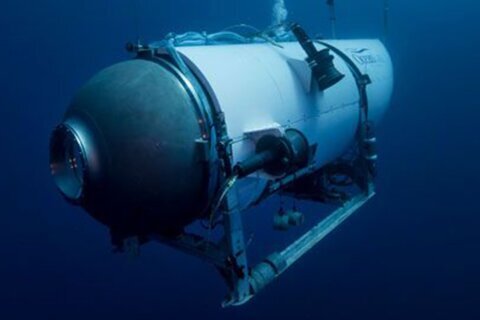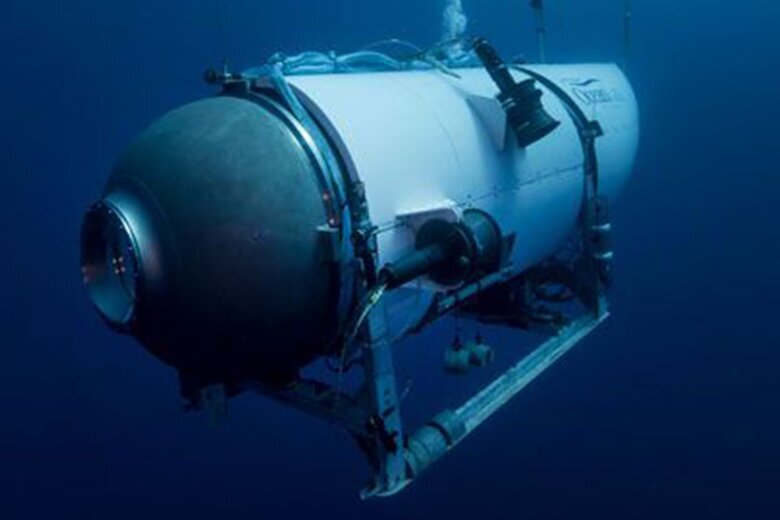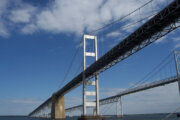
(CNN) — A multi-agency search is intensifying for a submersible that went missing with five people on board while touring the wreckage of the Titanic, as crews comb through choppy, remote waters in low visibility.
The Coast Guard and the Royal Canadian Air Force are deploying more aircraft and vessels to aid in the search as the clock ticks down on the oxygen available on the lost 21-foot vessel.
The search for the submersible – which has just four days of emergency capability – covers a remote area 900 miles east of Cape Cod and 13,000 feet deep, US Coast Guard District 1 Rear Admiral John Mauger said during a news conference.
“It is a challenge to conduct a search in that remote area,” Mauger said during a news briefing. “But we are deploying all available assets to make sure that we can locate the craft and rescue the people onboard.”
Crews are also dealing with foggy conditions and waves of 3 to 6 feet.
The small vessel – roughly the size of a minivan – was carrying one pilot and four “mission specialists” when its mothership lost contact with it Sunday morning, about 1 hour and 45 minutes into its descent to explore the Titanic wreckage, authorities said.
The vessel has between 70 and 96 hours of life support, Mauger said Monday afternoon.
It could be either on or below the surface of the water, and crews have been using sonar buoys and sonar capabilities on ships to listen for “any sounds that we can detect in the water column,” according to the coast guard.
There were no underwater searches involved as of Monday, Mauger said. The Coast Guard is using aerial and water surface vessels to search for the missing submersible, and more assets were expected to fan out for the search in the coming days.
“We have to make sure that we’re looking on both the surface using aerial and surface vessels, but then expanding into underwater search as well,” Mauger said. “Right now, our capability is limited to sonar buoys and listening for sounds.”
The Canadian Armed Forces is also deploying an aircraft to assist in the search for the missing submersible near the Titanic wreckage, a spokesperson told CNN.
The group that was conducting the Titanic expedition, OceanGate Expeditions, is also helping in the search and said it is “exploring and mobilizing all options to bring the crew back safely.”
Canadian research vessel the Polar Prince – which had taken the missing submersible to the site of the Titanic wreckage – is now assisting with the search and rescue efforts, a spokesperson for Horizon Maritime, a co-owner of the ship, told CNN.
“Our first thoughts are with the crew members and the families of those on board and so we want to make sure that we have done absolutely everything that we can do to locate their family members and bring them home safe,” Mauger said. “They are first and foremost in our thoughts every moment of this search operation.”
The US Coast Guard has not released the names of the five people on board the missing submersible as they are still in the process of notifying families, an official said Monday.
However, British businessman Hamish Harding is one of the people on the submersible, according to a social media post by the company he owns, Action Aviation.
The day before the vessel went missing, Harding wrote of the Titanic mission: “I am proud to finally announce that I joined OceanGate Expeditions for their RMS TITANIC Mission as a mission specialist on the sub going down to the Titanic.”
Harding also said in a social media post Saturday that diver PH Nargeolet was scheduled to be on Sunday’s dive with him.
“The team on the sub has a couple of legendary explorers, some of which have done over 30 dives to the RMS Titanic since the 1980s including PH Nargeolet,” Harding wrote in a Facebook post, according to CNN news partner CTV News.
Larry Daley, a St. John’s-based diver who reportedly made the trip to the Titanic two decades ago, also told CBC News that he knows one of the people on the expedition – French diver Paul-Henri Nargeolet.
It is not clear if Nargeolet was among those who boarded the vessel the morning after Harding’s social media post. CNN has attempted to reach out independently to Nargeolet with no success.
An archived version of OceanGate Expeditions’ website, accessible via the Internet Archive’s Wayback Machine, says PH Nargeolet is a Titanic expert who has taken the trip every year, completing more than 37 dives to the wreck.
Shahzada Dawood and his son, Sulaiman Dawood, from Pakistan had also “embarked on a journey to visit the remnants of the Titanic in the Atlantic Ocean,” according to a statement released by the family on Tuesday.
“As of now, contact has been lost with their submersible craft and there is limited information available,” the Dawood family says in their statement, adding that they’re praying for their loved ones’ safe return.
What we know about the vessel and expedition
The expedition began with a 400-nautical-mile journey to the Titanic wreck site, then the submersible started its descent Sunday morning, eventually losing contact with the Polar Prince – a converted ice breaker that transported the vessel to the site.
The last communication between the vessel and OceanGate staff at the surface came in at 11:47 a.m. Authorities weren’t notified until 6:35 p.m., after the 6:10 p.m. resurface time of the vessel had passed with no sign of the submersible, according to Miawpukek Maritime Horizon Services, which co-owns the Polar Prince.
Unlike a submarine, a submersible needs a mother ship to launch it, has fewer power reserves and can’t stay underwater as long.
A mother ship can communicate with a submersible “via text messages which are exchanged via a USBL (ultra-short baseline) acoustic system,” according to an archived version of OceanGate Expeditions’ website, accessible via the Internet Archive’s Wayback Machine.
The submersible is required to communicate with the ship every 15 minutes or more frequently if needed, according to the archived website. That USBL system is the only communications link between the submersible and the surface, the site adds.
OceanGate Expeditions operates a trip taking passengers to the Titanic’s wreckage at the bottom of the ocean for prices starting at $250,000, according to an archived version of its website calling that its “mission support fee” for a 2023 expedition.
The company’s Titanic expeditions include a series of eight-day missions to the famous shipwreck, and trips begin and end in St. John’s, Newfoundland, Canada, according to the archived website.
The company advertised the experience as a way “to step outside of everyday life and discover something truly extraordinary.” The vessel, named “Titan,” is a 23,000-pound submersible made of carbon fiber and titanium, according to OceanGate.
A Titanic dive takes approximately 10 hours from start to finish, including the two and a half hours it takes to reach the bottom, the website says.
The company calls its clients “mission specialists,” who are trained as crew members in a variety of different roles, including communicating with the topside tracking team, taking sonar scans and opening and closing the vessel’s dome, the archived website says.
Clients do not need any previous maritime experience to join as mission specialists, it adds.
In case of an emergency, the submersible is equipped with some basic emergency medical supplies and and the pilots have basic first aid training, according to OceanGate Expeditions’ website.
Chief Mi’sel Joe of Miawpukek First Nation the support vessel on the expedition, said he received a call Sunday afternoon alerting him the sub was two hours overdue and still hadn’t surfaced, and they had lost communication with the sub. At that point, requests for search and rescue had gone out, he said.
“There’s a tremendous amount of concern,” Chief Mi’sel Joe said. “I have anguish that people are going through this. I wish there was more I can do.”
Mothership crew ‘focused on board here for our friends’
An expedition participant on board the Polar Prince said Monday that everybody is “focused on board here for our friends.”
“We have a situation that is now the part of a major Search and Rescue effort, being undertaken by major agencies,” Rory Golden made the post on Facebook after being contacted by CNN. “That is where our focus is right now.”
Golden said that the online and internet options were being restricted “to keep bandwidth available for the coordinated effort that is taking place.”
“The reaction and offers of help globally is truly astonishing, and only goes to show the real goodness in people at a time like this,” he said.
Golden ended the post by thanking everyone and saying, “Think positive. We are.”
Search and rescue operations out at sea are like “searching for a needle in a haystack,” former US Navy diver, retired Capt. Bobbie Scholley, told CNN Monday.
“In this case, they knew exactly the location that they were starting with this submersible so they have good data for where to start the search,” Scholley said.
Scholley said 96 hours of life support on the vessel is “a short amount of time,” but added that effective resources are being used in the search.
The submersible is going to be making sounds itself with the systems on board, and sonar buoys should be able to pick up that sound, she said.
“The hard part is finding the submersible. And once they find the submersible, there are all sorts of situations of how to get that submersible to the surface, and rescue the crew,” Scholley said.
The Coast Guard’s current focus is on locating the vessel, Mauger said.
“If we find this vessel in the water, then we will have to affect some sort of rescue or reaching out to different partners within the US Navy, within the Canadian Armed Forces and within private industry to understand what underwater rescue capability might be available,” he added.
The-CNN-Wire
™ & © 2023 Cable News Network, Inc., a Warner Bros. Discovery Company. All rights reserved.







